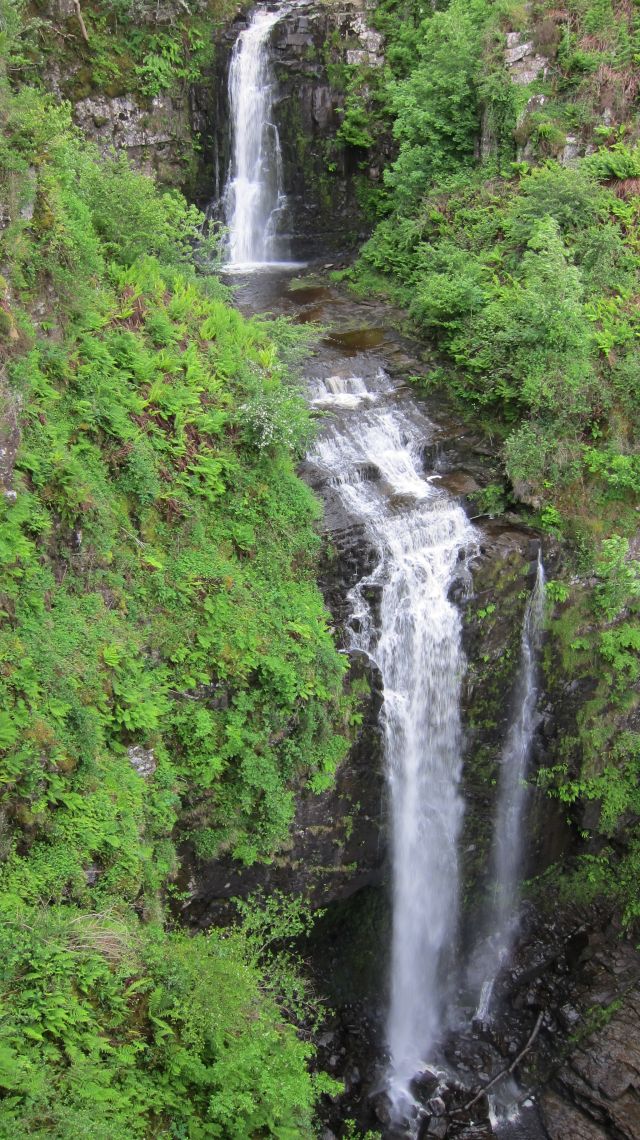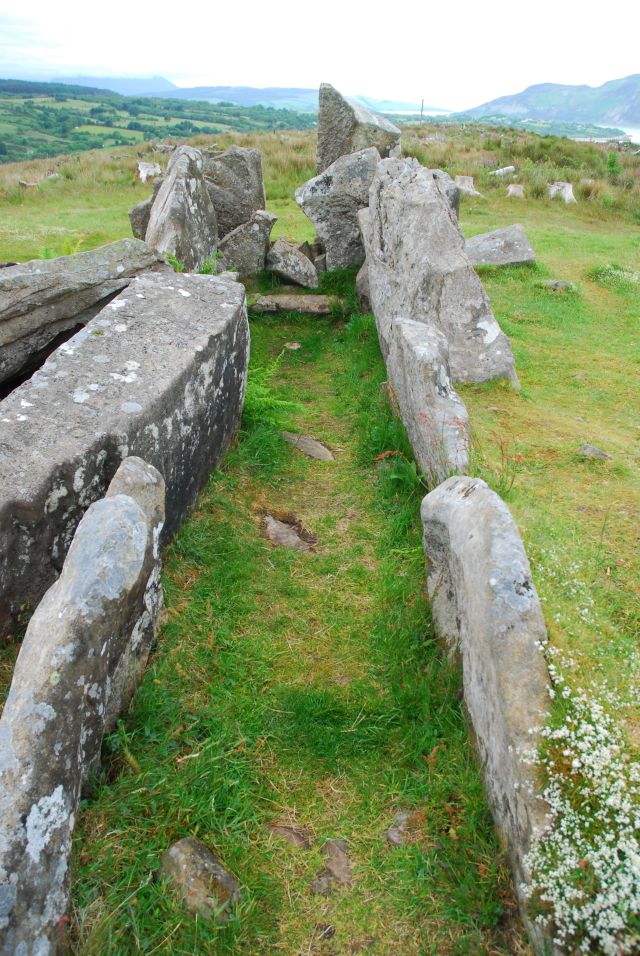‘Back to winter’ they say in the Co-op in Brodick. Lowering cloud, a chilly breeze: it all looks decidedly unpromising for a day’s walking. But as we set off up Glen Rosa, the valley that pokes a finger from Brodick Bay into the mountains of the north of Arran, things are starting to look brighter. By the end of the afternoon we will have had another brilliant walk, shedding layers as we go, as the sky clears and hot sunshine breaks through.
The walk up the glen is fairly flat and undemanding, gaining less than 200 metres in altitude before the final sharp climb to the ridge called The Saddle that overlooks Glen Sannox.For the first couple of miles the track leads past grassy meadows and wooded hillsides.
Soon, though, the valley becomes more bare of trees and shrubs, a consequence we learn later of grazing by deer and sheep that have rediced what once was extensive tree cover to small remnants.
Glen Rosa Water rushes along beside the track, crystal-clear water spilling over rocks and stones. To our right, the valley is overlooked by Goat Fell, the highest peak on the island, though it’s not possible to see it from the glen.
After a mile or so the glen turns to the north and the path crosses a bridge over another very busy stream that flows down the steep hillside in a series of waterfalls.
Now the valley ahead is dominated by the jagged peaks of Cir Mhòr which rises to 799 metres (2621 feet) and is sometimes called the ‘Matterhorn of Arran’. Its Gaelic name is translated into English as ‘Big Comb’, a reference to its resemblance to a cockscomb.
The landscape becomes increasingly wild and majestic,with bog cotton (common cottongrass) and wild orchids flanking the path. Yet, amazingly, this landscape is little more than two miles from the nearest supermarket.
It’s here that we think we identify a stonechat. At least, the bird we see seems to live up to its naming: it sits on a stone and chats, energetically and at great length. Norman MacCaig painted a vivid portrait of this bird, ‘a bright child throwing a tantrum’, in ‘Stonechat on Cul Beg’:
A flint-on-flint ticking – and there he is,
Trim and dandy – in square miles of bracken
And bogs and boulders a tiny work of art,
Bright as an illumination on a monkish parchment.
I queue up to watch him. He makes me a group
of solemn connoisseurs trying to see the brushstrokes.
I want to thumb the air in their knowing way.
I murmur Chinese black, I murmur alizarin.
But the little picture with four flirts and a delicate
Up-swinging’s landed on another boulder.
He gives me a stained-glass look and keeps
Chick-chacking at me. I suppose he’s swearing.
You’d expect something like oboes or piccolos
(Though other birds, too, have pebbles in their throats –
And of them I love best the airy skylark
Twittering like marbles squeezed in your fist).
Cul Beg looks away – his show’s been stolen.
And the up-staged loch would yawn if it could.
Only the benign sun in his fatherly way
Beams on his bright child throwing a tantrum.
By the time we stop for lunch, the sun is beating down. After, I take the dog and make the ascent to The Saddle: what is it about getting to the top to see what’s on the other side?
The climb is steeper now, but its only in the last few yards that it becomes a scramble. We reach the top, dog and I. Was ever a climb worth it! The views are spectacular, despite the heat haze. A small King Charles spaniel looks back down Glen Rosa with some astonishment, perhaps, at her achievement (top).
The view down Glen Sannox to the sea is breathtaking. Both these valleys were sculpted into classic U-shaped valleys during the last Ice Age, when the glacial ice flowed downhill to carve deeply into the rocks. There’s a poem by Norman MacCaig, ‘Humanism’, that meditates on the work of these glaciers millenia ago:
When the glacier was defeated
in the siege of Suilven and limped off
to the East, it left behind it all that
burdened its retreat –
stones, the size of
sandgrains and haystacks:
abandoned loot of Glen Canisp.
What a human lie is this. What greed and what
arrogance, not to allow
a glacier to be a glacier –
to humanise into a metaphor
that long slither of ice – that was no more
a beaten army than it was a horde
of Cinderellas, each,
when her midnight sounded,
leaving behind her
a sandstone shoe.
I defend the glacier that
when it absorbs a man
preserves his image
intact.
Well…it was a tough climb for a small dog. We pause to rest awhile before heading back down the glen and watch a chaffinch sing lustily on a nearby branch. On the way down we pass a man who asks if we’ve seen any adders – they have been plentiful this season, he says.
Part way along is the Glen Rosa Enclosure, a section of the valley fenced off from sheep and deer in order to allow the natural regeneration of woodland to take place and to increase wildlife diversity. It’s certainly having an effect: this enclosed area is rich in tree saplings, shrubs and heather largely absent beyond the fence.
It’s a pleasant walk back to the metalled track at the beginning of the glen. The sun is still warm, and as we pass the campsite young lads are plunging into the river.
Friday was our last day on the island, and we woke to steady rain – rain that had been forecast as a depression headed our way. But it was the cold that made the weather distinctly unseasonable: it was 10 C – or worse, with the wind chill factor in a stiff breeze.
After lunch, though, the rain moved off for a few hours, and we decided on a walk up Glenashdale to see the waterfall. For the most part, at least, we would be sheltered from the biting wind. The walk along Glenshdale begins at Whiting Bay, and follows the burn through mixed woodland, rich with the smell of wild garlic. The woodland floor was carpeted with the leaves of wood anemone and wild garlic (now over; it must have been a superb sight a few weeks ago).
When I saw this truck, with trees and shrubs growing through it, I was reminded of a scene in Werner Herzog’s recent film Into the Abyss, in which Herzog, probing the circumstances of a triple murder, chances upon the Camaro stolen by the murderers during the crime. A tree has grown up inside the vehicle during the decade it has stood in the police station parking lot.
A noticeboard along the trail informs visitors that Arran is one of the remaining strongholds of the red squirrel. There are no grey squirrels on Arran, which is the only Scottish island with a resident red squirrel population. So vigilance against any incursion by grey squirrels is of primary importance to safeguard red squirrels. Red squirrels seem unable to survive in the presence of greys, though the reasons for this are not fully understood. There is no evidence that grey squirrels aggressively chase out red squirrels, but grey squirrels seem to be more successful competing for food in different types of habitat – and they brought a disease, parapox virus, with them from America to which they are immune but which usually kills red squirrels.
Glenashdale Falls were a spectacular sight: it was easy to understand how this waterfall is regarded one of the most impressive waterfalls in the West of Scotland. The path to the area has been improved over the years and a viewing platform now juts out over the falls to give a clear view of the double drop.
The waterfall descends over 140 feet in two falls to a plunge pool, and then over another ledge to the river below.
We continued past the waterfall on the circular walk that takes you to the Giants’ Graves, neolithic graves that, at 5000 years old, pre-date the Egyptian pyramids.
Rather than being the final resting place of giants, as the legend says, the graves contained the bones of several people. Massive stone slabs, jumbled together in the turf, are all that remains of this large Stone Age burial cairn. There was once a forecourt, defined by large upright stones, with a rectangular burial chamber entered from the forecourt. The chamber was roofed with large slabs and enclosed in a stone cairn. Most of the smaller stones were removed long ago for walls and building materials. The cairn was excavated in 1902, and some burnt bone, pottery, flint knives and stone arrowheads were found.
Before they were placed in the cairn, bodies were left in the open to let the ravens remove the flesh from the bones, and different parts of the skeleton may have been placed in different parts of the chamber. People were sometimes buried with decorated pots, stone arrowheads and knives. The cairns were not permanently sealed but were used again and again over many years. The cairns were built using simple tools and required considerable communal effort. They were intended for the remains of the community’s ancestors, not just for individuals. The forecourts may have been used for rituals conducted during burial and in remembrance of the ancestors.
It’s a wild, windswept location, on a headland offering superb vistas of Whiting Bay and Holy Island. Looking down at the bay, we could see the waves, whipped up by the stiff wind, breaking on the beach below.
All that remained of our week on Arran now was the packing and the leaving. But, as Norman MacCaig observes in his poem ‘Landscape Outside and In’, we may leave the place behind, but the song of the landscape continues long after:
My rough ground lies under,
my scrub trees rise over
a tangle of grass half drowned
in a dazing wash of bluebells.
Four things, making a perpendicularity.
Beside them the loch water provides
the horizontal. It itches
with waterboatmen
and dimples with trout.
On top of all, on the high branches
I’m divided into birds, all singing.
How often do all my selves
sing together?..
You pick up a piece of wood,
a water sculpture; and we go to the car
and make for home.
We’ve left behind the bluebells
and the water. But all my selves
are still singing. They make no sound
but you hear their every note.

















































Very well composed piece – lovely pictures and superb write up…
Thank you, Ashish. Glad you enjoyed the post.
Really useful and lovely account of Glen Rosa and the Saddle. Sun’s out on Arran and we’re heading up to the Saddle today with our dog. Should be worth the walk.
Glad you enjoyed the post, Helen. Yes- the weather this week is upside down! Warm and sunny in the north, cold down south. Hope you had a lovely walk!
Had an amazing walk! Perfect weather, fabulous views and our lab loved every minute of it! So glad we did it – thanks again! :)